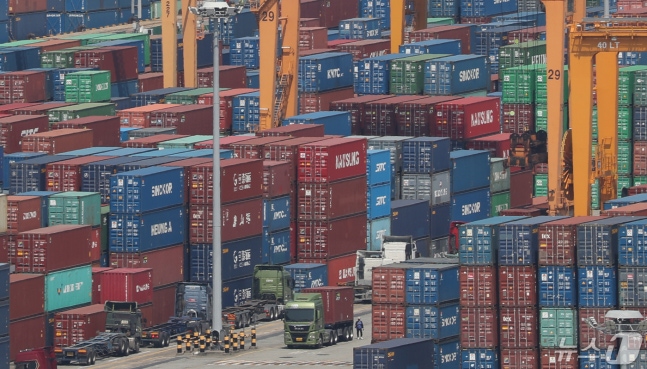Bank of Korea’s economic outlook box: “Benefiting from capital goods exports”
“US regulations to help South Korean semiconductor and automobile exports”,

(File photo) /News1,
,
, ‘(Seoul=News1) Reporter Kim Hye-ji = It is expected that the United States and China will continue their growth centered on domestic consumption this year, benefiting South Korean exports.’,
,
, ‘However, concerns have been raised about the negative impact on our exports in the long term as the division between the two major countries (G2) deepens.’,
,
, “The Bank of Korea’s ‘Evaluation and Implications on Recent G2 Economic Situation’ included such analysis in the May economic outlook box released on the 24th.”,
,
, ‘The report pointed out, “So far this year, with the United States and China showing good growth trends, the likelihood of a global soft landing is increasing,” and noted that “the recent good growth trends in the two countries are largely dependent on government fiscal stimulus measures.”‘,
,
, ‘It also stated, “Global fragmentation due to US-China tensions and intensified competition in advanced manufacturing industries are driving growth through industrial policies promoting investment.”‘,
,
, ‘Specifically, the United States is implementing industrial policies to promote corporate investment through measures such as the Innovation and Competition Act, semiconductor and science laws.’,
,
, ‘China has been providing implicit subsidies to export companies along with financial support for years.’,
,
, ‘The report analyzed, “In the first quarter, the increase in capital goods imports and equipment investment in the United States was due to the increase in production facilities at new factories as a result of industrial policy.”‘,
,
, ‘It also evaluated, “China is transitioning from labor-intensive industries to advanced manufacturing and high value-added industries,” noting that “investment in manufacturing and social indirect capital (SOC) increased in the first quarter.”‘,
,
, ‘In response, the report forecasted, “This year, G2 economies will continue their growth trend centered on domestic demand thanks to fiscal and industrial policies.”‘,
,
, ‘In the case of the United States, with the ongoing labor demand and additional government fiscal support, a positive trend of continued consumption growth is expected. Industrial policy-related facility investments and data center investments are also expected.’,
,
, ‘In the case of China, it is expected that the growth trend will gradually shift to domestic demand as it is difficult to expect export improvements due to trade frictions with the United States, while increasing private consumption and expanding investment in advanced industries through policy support.’,
,
, ‘Ultimately, the report suggested, “The domestic demand-oriented growth trend in the G2 economies is a positive factor for South Korean exports in the short term,” and predicted that “the expansion of US-China investment will affect South Korea’s capital goods exports.” It further anticipated, “US export regulations against China will help boost exports of South Korea’s key products such as semiconductors and automobiles.”‘,
,
, ‘However, it expressed concerns that “as fragmentation between countries deepens and self-reliance on domestic production increases in each country, there is a growing possibility that our exports will also be negatively affected.”‘,
,
, ‘The report was prepared by Choi Byeong-jae, a deputy director in the Bank of Korea’s International Department, and research officers Ko Min-ji and Baek Chang-in from the US-Europe Economic Team, and research officers Kim Ji-hyun and Lee Sang-heon from the China Economic Team.\n’]

